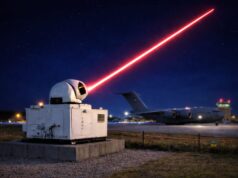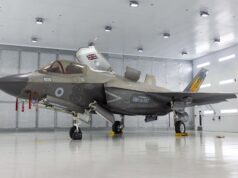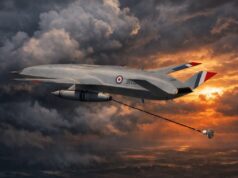Lockheed Martin has selected Harris Corporation to develop and deliver the next generation Integrated Core Processor (ICP) for the F-35 fighter jet.
The Lockheed Martin-led competition within the F-35 supply chain will significantly reduce cost and enhance capability.
The F-35’s ICP acts as the brains of the F-35, processing data for the aircraft’s communications, sensors, electronic warfare, guidance and control, cockpit and helmet displays.
“We are aggressively pursuing cost reduction across the F-35 enterprise and, after conducting a thorough review and robust competition, we’re confident the next generation Integrated Core Processor will reduce costs and deliver transformational capabilities for the warfighter,” said Greg Ulmer, Lockheed Martin vice president and general manager of the F-35 programme.
“The next generation Integrated Core Processor for the F-35 will have positive benefits for all customers in terms of life cycle cost, capability, reliability and more.”
According to the company, the new Integrated Core Processor is a key element of the planned “Technology Refresh 3” modernization that takes advantage of fast evolving computing power to ensure the advanced F-35 remains ahead of evolving threats. Additional elements in the tech refresh include the Panoramic Cockpit Display Electronic Unit and Aircraft Memory System, which were also recompeted and awarded to Harris last year.
The Harris-built ICP will be integrated into F-35 aircraft starting with Lot 15 aircraft, expected to begin deliveries in 2023. The next generation ICP system is targeted to generate the following results compared to the current system:
- 75 percent reduction in unit cost
- 25 times increase in computing power to support planned capability enhancements
- Greater software stability, higher reliability, and increased diagnostics resulting in lower sustainment costs
- An Open System Architecture to enable the flexibility to add, upgrade and update future capabilities
“The new F-35 ICP will pave the way for system scalability well into the future,” said Ed Zoiss, president, Harris Electronic Systems.
“Open systems are the future of avionics and Harris has invested substantial R&D to deliver more affordable and higher performance solutions than would have been possible using proprietary technology.”













Yet another reason to hold off ordering in bulk, but I do think we should order 48 planes in lot 15 to get a critical mass going.
Either we need the planes or we don’t. Waiting for future upgrades or cost cuts, means we don’t need them and so shouldnt order at all, which is clealry nonsense as we need them to justify the carrier’s and so need them now not in 5 or 10 years time.
Our government seems to consider defence spending in isolation to the threat, thinking that we control when we are attacked, which only works for when we are the attacker but equally we don’t decide the US does. The problem is a real war feels so remote a probability today that it is hard to justify the spending, but capability isn’t created overnight and so gaps are scary and result in the mess that happenend in Iraq/Afghan. Anyone that tells me that no one saw a counter insurgency war as a possibility is clearly ignoring most wars that happened over history, outside the big ones.
Pacman, we should buy them as needs require. The F35 is never going to be “finished”. It will be constantly upgraded and enhanced throughout its lifetime.
What they have done with the F35 programme is not wait until it is ‘perfect’ before beginning production. That approach would produce an aircraft eventually, but which would be obsolete the day it was deployed.
Instead they’ve developed a future proofed platform which they can correct, refine, and enhance in a constant cycle. This reduces the time taken for new technologies to progress from the lab to the front-line.
Essentially they’ve adopted the software concept of “agile development” and applied it to a weapons platform. It means the F35 will be at the for front of military aircraft technology for decades to come.
If the “wait until the upgrade ” philosophy is used you never buy anything.
From my own experience the first T23 ( Norfolk) did not have a working command system when it came into the fleet. The last T23 St Albans was completely different in layout and equipment when we got that from the builders.
Military equipment is constantly evolving, improving and being upgraded. Upgrades are the things that make the money for the builders!
Whats “software stability” code for?
Yeah, that’s a bit intriguing. I suppose it could mean a number of things. Maybe the new processor supports error-correcting memory, what is called “ECC” memory, whereas the exiting ones might not. For instance in the consumer world desktop processors from Intel don’t support ECC memory whereas AMD processors do (or at least did a generation or two ago, I haven’t kept up to date with AMD stuff). That means that the processor can detect and often correct memory contents if they have become corrupted somehow. It’s also possible that the new processors trap more error conditions that can occur in badly written code, e.g. what are called “null pointer references” which the previous processor might not have done (e.g. the reference platform for Unix in the 1980s and 1990s, AT&T’s 3B2 computer, didn’t trap null pointer references so a whole host of software bugs related to those were never discovered when running on the reference platform but once the code was ported to a different processor all the errors started getting flagged and the code could be corrected).
Then again, it could also be marketing fluff from a press release written by someone who knows nothing about the technology so is essentially nonsense. It would be quite interesting to see the spec on the old and new architectures because 25x speed up is dramatic but I suspect all of it is classified.
The cost of upgrading to Block 4 which amongst other things allows the F-35B to deliver its weapons capabilities is going to be a very costly exercise, so it would be prudent to wait and see what the actual cost is going to be before buying any more airframes.
2024/2025 should be the time to consider purchasing more F35’s as we will have a better understanding of where we are with the outstanding fixes already identified (900+) and hopefully the internal fitting of Meteor.
“In a Dec. 19 report, the House of Commons Defence Committee wrote (p. 23) that “Lockheed
Martin also informed the Committee that following the completion of the SDD phase, the partner nations in the programme “are committed to developing enhancements to in-service aircraft through ‘Continuous Capability Development and Delivery (C2/D2)”. According to Lockheed Martin, they expect the UK to “pay approximately 4.5% of the total cost to develop and integrate new capabilities into the F-35”.
http://www.defense-aerospace.com/articles-view/feature/5/191396/cost-of-f_35-block-4-upgrade-quadruples-but-may-not-suffice.html
full to deliver its weapons capabilities sorry
What is also very interesting to see is how the USA are upgrading the stealth and range of the F-15SE Silent Eagle And Advance F-18E Super Hornet, very smart thinking short to mid-term and not placing all their eggs in one basket. We should be doing the same thing with Typhoon.
https://www.youtube.com/watch?v=YYDCfR4Na-I
Typhoon already has most of these stealth features.
Link courtesy of Helions.
In relation to expected costs,
Friday’s crash was the second Class-A mishap by an F-35, Harrison said.
In June, Popular Mechanics reported that a Government Accountability Office (GAO) report found the F-35 had “nearly a thousand ‘deficiencies’” as it nears time for a decision on full production of the fighter.
“In 2019, (the Department of Defense) will decide whether to enter full-rate production for the F-35aircraft, the most expensive and ambitious weapon acquisition program in U.S. military history,” the GAO report, dated June 13, says.
“DOD has already requested the $9.8 billion it will need for 2019, and it will continue to request more over the next two decades—about $10.4 billion annually,” the GAO report continued. “However, the F-35 is just one program in DOD’s vast acquisition portfolio, raising questions about its long-term affordability.”
Over a 60-year “life-cycle” period, it’s estimated that it will take more than 1 trillion dollars to sustain the F-35 program, according to the report.”
https://www.charlotteobserver.com/news/state/south-carolina/article219182290.html
We’re in a different situation to the US in that we don’t have an existing, operational, fixed-wing carrier capability. We cannot afford to wait until 2025 before ordaining the F35 to be sufficiently mature to order aircraft en masse.
The point about the government looking at defence without regard to threat is well taken. The government is building peace-time armed forces. In the event of unexpected conflict with a peer opponent, half our fleet will be unavailable due to the widespread practice of cannibalising ships to enable others to be made operational. Supplies of key weapons like cruise missiles will be exhausted within days. A lack of escorts, maritime patrol and fighter aircraft, pilots, and submarines will limit the ability of the fleet to deploy to contested areas.
On land, insufficient numbers of MBTs and mobile anti-aircraft systems will make it unlikely that we could deploy to mainland Europe without leaving the home island virtually undefended.
In short, the armed forces would be virtually paralyzed if a conflict with Russia were to occur. If a conflict with China loomed, we could offer precious little help to allies. We have armed forces that are unfit for their primary purpose. There’s no point in trying to maintain war-fighting ability unless we do it properly. That’s the bottom line.
As Gunbuster pointed out, in-life and upgrades in later units coming off a production line are a pretty standard thing. The F-35 is a modern program and I would be very surprised if it hasn’t allowed for this by having very well defined housing enclosure sizes, shapes and maximum weights plus well-defined signal and power entry and exit points to those enclosures, defined cooling capabilities and details, etc such that a processor upgrade is a matter of swapping out one or more boxes for others with more modern internals. We won’t be talking about structural upgrades here.
Modularity is also good for maintainability of course – Main processor fails in the field? Disconnect power and data connectors and any liquid and/or air cooling connections, pull out the failed unit and install a replacement. There’s a double benefit from designing it into a complex system from the start and making sure it’s done properly.
F-35 is a big and complicated program and each LRIP is negotiated separately. If we did want to up out order on the cusp of the new processor going into production I am sure LM etc would want to help remove any barriers to our accelerating our buy rate, e.g possible delivering sans-upgrade and supplying it when available with possibly a special deal such that we are only renting the main processor unit on the newly delivered aircraft for as long as we need to until the new processor is available for upgrade. I’m not saying that is necessarily the realistic or possible solution (although it might be), just saying that if 2 parties both want something to happen during a contract negotiation then a way can usually be found to negotiate something to put in the contract to enable it.